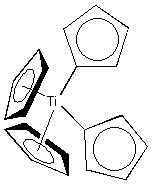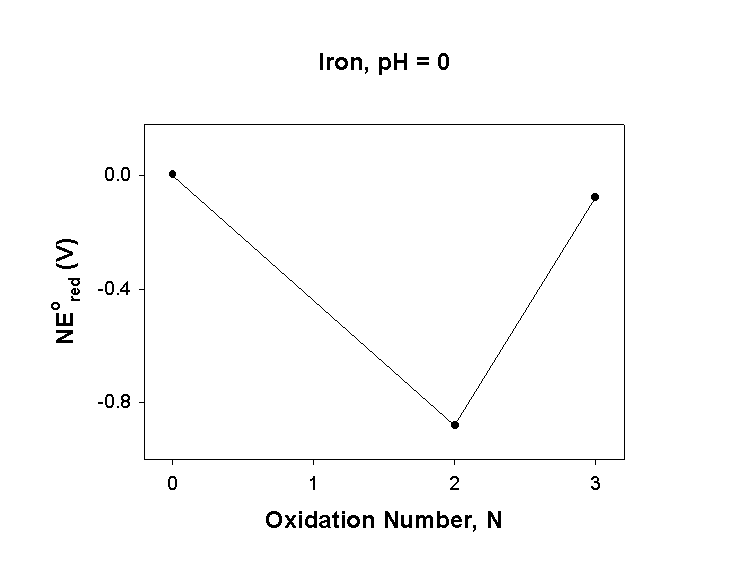Chemistry 401
Intermediate Inorganic Chemistry
University of Rhode Island
Fall 1999
Exam 3
1. Does ΔH° calculated using the Drago/Wayland equation agree with the Donor Number for the listed bases? Why or why not? Suppose trimethyltin chloride had been used as the standard for the DN scale; would this change the order of base strength for the listed bases? Why or why not?
kJ/molEACA
SbCl515.110.5
(CH3)3SnCl11.80.0605
EBCB
pyridine2.3913.1
tetrahydrofuran2.008.73
acetone2.024.70
–ΔH° = EAEB + CACB
For SbCl5:
pyridine: ΔH° = –[(15.1)(2.39) + (10.5)(13.1)] = -173.6 kJ/mol, DN = 33.1
THF: ΔH° = –[(15.1)(2.00) + (10.5)(8.73)] = -121.9 kJ/mol, DN = 20.0
acetone: ΔH° = –[(15.1)(2.02) + (10.5)(4.70)] = -79.9 kJ/mol, DN = 17.0
The donor number and calculated ΔH° parallel each other, as they should. DN is based on the heat of reaction.
For (CH3)3SnCl:
pyridine: ΔH° = –[(11.8)(2.39) + (0.0605)(13.1)] = -29.0 kJ/mol, DN = 33.1
THF: ΔH° = –[(11.8)(2.00) + (0.0605)(8.73)] = -24.1 kJ/mol, DN = 20.0
acetone: ΔH° = –[(11.8)(2.02) + (0.0605)(4.70)] = -24.1 kJ/mol, DN = 17.0
In this case, the relative basicities of the three bases is apparently dramatically reduced and THF and acetone appear to have the same base strength. A donor number scale based on trimethyltin chloride would be of more limited use.
2. Use the information in the Latimer diagram to construct the Frost diagram for iron in acidic solution. Use the provided graph paper and label each axis.

N = 0: Fe + 0e– → Fe E° = 0, NE° = 0
N = 2 : Fe2+ + 2e– → Fe E° = –0.44, NE° = –0.88
N = 3: Fe3+ + 3e– → Fe E° = –0.04, NE° = –0.08
Plot:
3. [Ru(bipy)3]3+ is a strong oxidizing agent that nearly always undergoes electron transfer by an outer sphere mechanism. Why is the mechanism outer sphere? What kinetic advantages might this oxidizing agent possess over a weaker oxidizing agent?
The structure of [Ru(bipy)3]3+ is shown below:
All of the octahedral sites are occupied by a strong field ligand so there is no energetic gain by substitution to form an inner-sphere complex. Because of the large potential (1.53 V), there is enough thermodynamic driving force to overcome the overpotential for most redox reactions. Also, since the mechanism is outer sphere, there is less likelihood of atom transfer occurring along with the electron transfer.
4. Balance the following reaction under acidic conditions:
CrO42–(aq) + H2SO3(aq) → Cr3+(aq) + HSO4–(aq)
CrO42–(aq) + 8 H+(aq) + 3 e– → Cr3+(aq) + 4 H2O(l)
H2SO3(aq) + H2O(l) → HSO4–(aq) + 3 H+(aq) + 2 e–
After eliminating electrons, the net equation is:
2 CrO42–(aq) + 3 H2SO3(aq) + 7 H+(aq) → 2 Cr3+(aq) + 3 HSO4–(aq) + 5 H2O(l)
5. Name the following: a) [Fe(NH3)5Cl]SO4
b) 
a) pentaamminechloroiron(III) sulfate
b) bis-(η1-cyclopentadienyl)-bis-η5-cyclopentadienyl)titanium(IV)
6. Give the structure for mer-triamminebromo-cis-dichlorocobalt(III).
7. Consider hexacyanochromate(III) and hexaaquachromium(III) ions. Find the LFSE for each; which will be larger? Estimate the spin-only magnetic moment for each ion in units of Bohr-Magnetons.
[Cr(CN)6]3– and [Cr(H2O)6]3+ ions both have d3 electron configurations for the metal, so in an octahedral field the configuration is t2g3 and the LFSE = –12Dq. Since cyanide is a much stronger ligand than water, the LFSE for [Cr(CN)6]3– will be larger. Both complexes will have 3 unpaired spins so the spin-only magnetic moment is estimated to be




